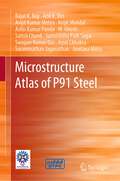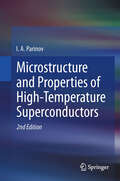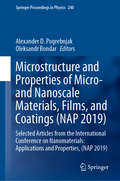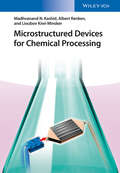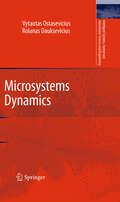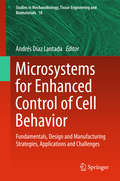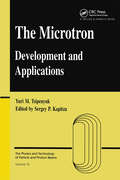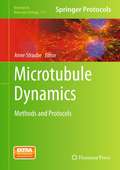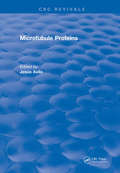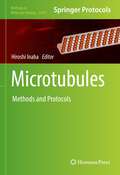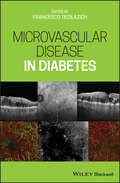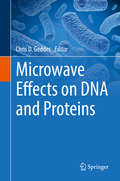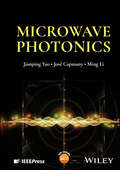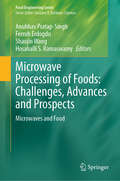- Table View
- List View
Microstructure Atlas of P91 Steel
by Amitava Mitra Sarmishtha Palit Sagar M. Ghosh Rajat K. Roy Anil K. Das Avijit Kumar Metya Avijit Mondal Ashis Kumar Panda Satish Chand Swapan Kumar Das Amit Chhabra Swaminathan JaganathanThis book highlights the qualitative and quantitative sequential changes in microstructure of P91 steel under various stress and temperature conditions. The P91 alloy is an established material used under elevated temperature and stress in the components of thermal power plants. Temperature and stress levels for laboratory experimentation have been selected based on the true operating condition of a boiler. This book describes both full length as well as interrupted tests that were performed under given parameters. Subsequently, the microstructures, bulk hardness and NDE parameters (magnetic and non-linear ultrasonic) have been evaluated. For reliable data, the microstructures have been observed at different regions of creep exposed samples by different characterization techniques. This has been further followed by drawing co-relation between specific features like precipitate size variation with creep strain / creep time and so on. Given the contents, this book will be a useful reference for researchers and professionals working in the area of materials especially in thermal power plants.
Microstructure and Properties of High-Temperature Superconductors
by I. A. ParinovThe main features of high-temperature superconductors (HTSC) that define their properties are intrinsic brittleness of oxide cuprates, the layered anisotropic structure and the supershort coherence length. Taking into account these features, this treatise presents research into HTSC microstructure and properties, and also explores the possibilities of optimization of the preparation techniques and superconducting compositions. The "composition-technique-experiment-theory-model," employed here, assumes considerable HTSC defectiveness and structure heterogeneity and helps to draw a comprehensive picture of modern representations of the microstructure, strength and the related structure-sensitive properties of the materials considered. Special attention is devoted to the Bi-Sr-Ca-Cu-O and Y-Ba-Cu-O families, which currently offer the most promising applications. Including a great number of illustrations and references, this monograph addresses students, post-graduate students and specialists, taking part in the development, preparation and research of new materials. The new edition had been updated intensively, especially experimental investigations and modeling conductive and elastic properties of HTC superconductors have been added.
Microstructure and Properties of Micro- and Nanoscale Materials, Films, and Coatings: Selected Articles from the International Conference on Nanomaterials: Applications and Properties, (NAP 2019) (Springer Proceedings in Physics #240)
by Alexander D. Pogrebnjak Oleksandr BondarThis book presents the findings of experimental and theoretical (including first-principles molecular dynamics simulation) studies of nanostructured and nanocomposite metal-based materials, and nanoscale multilayer coatings fabricated by physical or chemical vapor deposition, magnetron sputtering, electrospark alloying, ionic layer absorption, contact melting, and high-current electron beam irradiation. It also discusses novel methods of nanocomposite formation, as well as the structure of the deposited films, coatings and other nanoscale materials, their elemental and phase composition, and their physical–mechanical, tribological, magnetic and electrical properties. Lastly, it explores the influence of a various surface modification methods, such as thermal annealing, pulsed laser modification, and thermomechanical and ultrasonic treatment, as well as different properties of nanostructured films.
Microstructure of Metals and Alloys: An Atlas of Transmission Electron Microscopy Images
by Ganka Zlateva Zlatanka MartinovaA teaching tool intended to complement existing books on the theory of materials science, metallurgy, and electron microscopy, this text focuses on metals and alloys. It visualizes key structural elements common to crystalline materials, including crystal lattice imperfections, along with the principles and steps involved in the microstructure deve
Microstructured Devices for Chemical Processing
by Madhvanand N. Kashid Lioubov Kiwi-Minsker Albert RenkenBased on courses taught by the authors, this advanced textbook discusses opportunities for achieving larger-scale reactions in a technically controllable, sustainable, cost-effective and safe manner. Adopting a practical approach, it describes how miniaturized devices are used successfully for process intensification, focusing on the engineering aspects of microstructured devices, such as their design and characterization for homogeneous and multiphase reactions. It addresses the conditions under which microstructured devices are beneficial, how they should be designed, and how such devices can be integrated in a chemical process. Essential for master and doctoral students, as well as professional chemists and chemical engineers working in this area.
Microstructured Materials: Inverse Problems
by Jüri Engelbrecht Jaan JannoComplex, microstructured materials are widely used in industry and technology and include alloys, ceramics and composites. Focusing on non-destructive evaluation (NDE), this book explores in detail the mathematical modeling and inverse problems encountered when using ultrasound to investigate heterogeneous microstructured materials. The outstanding features of the text are firstly, a clear description of both linear and nonlinear mathematical models derived for modelling the propagation of ultrasonic deformation waves, and secondly, the provision of solutions to the corresponding inverse problems that determine the physical parameters of the models. The data are related to nonlinearities at both a macro- and micro- level, as well as to dispersion. The authors' goal has been to construct algorithms that allow us to determine the parameters within which we are required to characterize microstructure. To achieve this, the authors not only use conventional harmonic waves, but also propose a novel methodology based on using solitary waves in NDE. The book analyzes the uniqueness and stability of the solutions, in addition to providing numerical examples.
Microsystems Dynamics
by Vytautas Ostasevicius Rolanas DaukseviciusIn recent years microelectromechanical systems (MEMS) have emerged as a new technology with enormous application potential. MEMS manufacturing techniques are essentially the same as those used in the semiconductor industry, therefore they can be produced in large quantities at low cost. The added benefits of lightweight, miniature size and low energy consumption make MEMS commercialization very attractive. Modeling and simulation is an indispensable tool in the process of studying these new dynamic phenomena, development of new microdevices and improvement of the existing designs. MEMS technology is inherently multidisciplinary since operation of microdevices involves interaction of several energy domains of different physical nature, for example, mechanical, fluidic and electric forces. Dynamic behavior of contact-type electrostatic microactuators, such as a microswitches, is determined by nonlinear fluidic-structural, electrostatic-structural and vibro-impact interactions. The latter is particularly important: Therefore it is crucial to develop accurate computational models for numerical analysis of the aforementioned interactions in order to better understand coupled-field effects, study important system dynamic characteristics and thereby formulate guidelines for the development of more reliable microdevices with enhanced performance, reliability and functionality.
Microsystems for Enhanced Control of Cell Behavior
by Andrés Díaz LantadaThis handbook focuses on the entire development process of biomedical microsystems that promote special interactions with cells. Fundamentals of cell biology and mechanobiology are described as necessary preparatory input for design tasks. Advanced design, simulation, and micro/nanomanufacturing resources, whose combined use enables the development of biomedical microsystems capable of interacting at a cellular level, are covered in depth. A detailed series of chapters is then devoted to applications based on microsystems that offer enhanced cellular control, including microfluidic devices for diagnosis and therapy, cell-based sensors and actuators (smart biodevices), microstructured prostheses for improvement of biocompatibility, microstructured and microtextured cell culture matrices for promotion of cell growth and differentiation, electrophoretic microsystems for study of cell mechanics, microstructured and microtextured biodevices for study of cell adhesion and dynamics, and biomimetic microsystems (including organs-on-chips), among others. Challenges relating to the development of reliable in vitro biomimetic microsystems, the design and manufacture of complex geometries, and biofabrication are also discussed.
Microtron: Development and Applications
by Yuri M. TsipenyukThe Microtron: Development and Applications is a comprehensive monograph that sums up more than 30 years of research and development in microtron technology and applications and provides a systematic presentation of results from investigations carried out in Russia and abroad. The first part describes the basic principles of various types of microt
Microtubule Dynamics
by Anne StraubeMicrotubules are at the heart of cellular self-organization, and their dynamic nature allows them to explore the intracellular space and mediate the transport of cargoes from the nucleus to the outer edges of the cell and back. In Microtubule Dynamics: Methods and Protocols, experts in the field provide an up-to-date collection of methods and approaches that are used to investigate microtubule dynamics in vitro and in cells. Beginning with the question of how to analyze microtubule dynamics, the volume continues with detailed descriptions of how to isolate tubulin from different sources and with different posttranslational modifications, methods used to study microtubule dynamics and microtubule interactions in vitro, techniques to investigate the ultrastructure of microtubules and associated proteins, assays to study microtubule nucleation, turnover, and force production in cells, as well as approaches to isolate novel microtubule-associated proteins and their interacting proteins. Written in the highly successful Methods in Molecular BiologyTM series format, chapters include introductions to their respective topics, lists of the necessary materials and reagents, step-by-step, readily reproducible laboratory protocols, and tips on troubleshooting and avoiding known pitfalls. Definitive and practical, Microtubule Dynamics: Methods and Protocols provides the key protocols needed by novices and experts on how to perform a broad range of well-established and newly-emerging techniques in this vital field.
Microtubule Proteins
by Jesus AvilaThis work focuses on the structural and functional description of the microtubule proteins. The objective of the authors is to establish a relationship between the structure of microtubule proteins and the functions in which these polymers are involved. This book covers topics which have been treated only in a preliminary manner in previous works, such as microtubule dynamics and microtubule poisons. Microtubules display a variety of cellular roles and are vital for the separation and correct distribution of chromosomes during cell division. They also play an important role in morphogenesis, intracellular transport, secretion, and motility. Microtubule Proteins is a concise, easy-to-read text which is particularly of interest to cell biologists, chemists, neurochemists, and graduate students interested in cell biology.
Microtubule Protocols
by Jun ZhouThis book presents a comprehensive collection of essential and up-to-date methods for studying both the biology of microtubules and the mechanisms of action of microtubule-interacting drugs. The book contains a straightforward presentation of readily reproducible protocols, tips for troubleshooting, and advice on avoiding common mistakes. Basic scientists and clinical researchers will benefit from this collection.
Microtubules: Methods and Protocols (Methods in Molecular Biology #2430)
by Hiroshi InabaThis volume provides state-of-the-art methodology to functionalize microtubules and construct microtubule-based materials. Chapters consists of six sections detailing modification of microtubule structures, observation and control of microtubule movement, material applications of microtubules in vitro, development of microtubule-binding molecules, comprehensive approaches to analyze properties of microtubules, and functionalization of microtubules in living cells. Written in the highly successful Methods in Molecular Biology series format, chapters include introductions to their respective topics, lists of the necessary materials and reagents, step-by-step, readily reproducible laboratory protocols, and tips on troubleshooting and avoiding known pitfalls. Authoritative and cutting-edge, Microtubules: Methods and Protocols aims to provide useful information for construction of microtubule-based materials and help to create new ideas for the next-generation of materials and applications through detailed protocols.
Microvascular Disease in Diabetes
by Francesco TecilazichPresents comprehensive coverage of the many microvascular complications of diabetes Diabetes remains one of the main causes, in the western world, of legal blindness, end stage renal disease, and amputation, despite the implementation of tight glycemic control and the great progress in the management and care of our patients. This book provides a useful and handy tool to professionals and students in the field of diabetes and its microvascular complications by integrating information from clinical settings as well as from the frontlines of diabetic research. It provides readers with up-to-date diagnostic criteria, classifications, and therapeutic approaches. and recent discoveries on mechanisms of disease, experimental therapeutic agents, and biomarkers of disease. Written by top experts in the field, Microvascular Disease in Diabetes offers in-depth chapters covering pathophysiology; the genetics of diabetic microvascular disease; and the epigenetics of diabetic microvascular disease. It then provides sections featuring both clinical and research information on diabetic retinopathy, diabetic nephropathy, diabetic neuropathy, and diabetic foot. It also looks at coronary microvascular dysfunction and cerebral microvascular disease. Integrates new and accessible material on diabetic microvascular comorbidities Covers all relevant microvascular systems Provides a much-needed resource synthesizing research and clinical applications to treating microvascular complications of diabetes Presents current diagnostic criteria, classifications, and therapeutic approaches, as well as recent discoveries on the mechanisms of disease, experimental therapeutic agents, and biomarkers of disease Assembled in an easily consultable manner, Microvascular Disease in Diabetes is an excellent text for investigators, clinicians, and students looking to improve their understanding of diabetic complications.
Microwave Analysis of Unconventional Superconductors with Coplanar-Resonator Techniques (PoliTO Springer Series)
by Gianluca Ghigo Daniele TorselloThis book provides a thorough overview of methods and approaches to the experimental characterization of superconductors at microwave frequencies, and includes a detailed description of the two main techniques, both based on the use of coplanar waveguide resonators, that the authors employed to investigate the properties of unconventional superconductors. In the second part several case studies are described, covering a large spectrum of materials and issues. Particular emphasis is given to recent hot topics concerning iron-based superconductors, both of fundamental nature and relevant for applications. The book is intended as a learning tool for researchers in the field, and serves as a guide providing inspiring examples of the use of coplanar resonator techniques to address key topics in the field of unconventional superconductivity.
Microwave Cavities and Detectors for Axion Research: Proceedings of the 2nd International Workshop (Springer Proceedings in Physics #211)
by Gianpaolo Carosi Gray Rybka Karl Van BibberThe nature of dark matter remains one of the preeminent mysteries in physics and cosmology. It appears to require the existence of new particles whose interactions to ordinary matter are extraordinarily feeble. One well-motivated candidate is the axion, an extraordinarily light neutral particle that may possibly be detected by looking for their conversion to detectable microwaves in the presence of a strong magnetic field. This has led to a number of experimental searches that are beginning to probe plausible axion model space and may discover the axion in the near future. These proceedings discuss the challenges of designing and operating tunable resonant cavities and detectors at ultralow temperatures. The topics discussed here have potential application far beyond the field of dark matter detection and may be applied to resonant cavities for accelerators as well as designing superconducting detectors for quantum information and computing applications. This work is intended for graduate students and researchers interested in learning the unique requirements for designing and operating microwave cavities and detectors for direct axion searches and to introduce several proposed experimental concepts that are still in the prototype stage.
Microwave Cavities and Detectors for Axion Research: Proceedings of the 3rd International Workshop (Springer Proceedings in Physics #245)
by Gianpaolo Carosi Gray RybkaThe nature of dark matter remains one of the preeminent mysteries in physics and cosmology. It appears to require the existence of new particles whose interactions with ordinary matter are extraordinarily feeble. One well-motivated candidate is the axion, an extraordinarily light neutral particle that may possibly be detected by looking for their conversion to detectable microwaves in the presence of a strong magnetic field. This has led to a number of experimental searches that are beginning to probe plausible axion model space and may reveal the axion in the near future. These proceedings discuss the challenges of designing and operating tunable resonant cavities and detectors at ultralow temperatures. The topics discussed here have potential application far beyond the field of dark matter detection and may be applied to resonant cavities for accelerators as well as designing superconducting detectors for quantum information and computing applications. This work is intended for graduate students and researchers interested in learning the unique requirements for designing and operating microwave cavities and detectors for direct axion searches and to introduce several proposed experimental concepts that are still in the prototype stage.
Microwave Chemical and Materials Processing: A Tutorial
by Nick Serpone Satoshi Horikoshi Robert F. Schiffmann Jun Fukushima José M. Catalá-Civera Tomohiko MitaniThis book adds remarkable advances in microwave chemistry, methods, equipment, and practical examples since the first edition was published in 2018. Moreover, practical examples of the use of microwave energy have been upgraded. It also includes how to easily predict microwave heating using material constants. In addition, coupling analysis simulation with electromagnetic fields and heat transfer which greatly support researchers' experiments is covered. The principal aim of this book hasn’t changed: to introduce chemists through a tutorial approach to the use of microwaves by examining several experiments of microwave chemistry and materials processing. It subsequently enables chemists to fashion their own experiments in microwave chemistry or materials processing. This book helps chemists who take an interest in the use of microwave radiation to overcome difficulties to understand the nature of electromagnetism, microwave engineering, and thermodynamics.
Microwave Dielectric Spectroscopy of Ferroelectrics and Related Materials
by Jonas GrigasIn this important book, the author summarizes and generalizes the results of 25 years of work in this exciting field, which has been developing extensively within the last few decades. The reader will find discussions of many crystals that were investigated in the microwave region, including low-dimensional and ferroelectric semiconductors, protonic conductors, quasi-one-dimensional H-bonded. and other order-disorder ferroelectrics. This volume is an essential reference for all scientists and graduate students whose interests are connected to the physics of ferroelectrics and related materials; the physics of structural phase transitions; and superionic conductors. It will also be of value to those interested in developing or exploiting microwave measurement techniques.
Microwave Effects on DNA and Proteins
by Chris D. GeddesFor several years, researchers have been reporting the effects of microwave radiation/heating on both the structure and function of DNA, RNA and proteins. For the most part, favourable accelerated biological functions are observed as microwave induced heating occurs, but other not-so favourable effects are also observed, such as denaturation, fragmentation and the so called and ill-explained, non-thermal microwave effects. This volume, the first of its kind, brings researchers together from around the world to discuss their current findings and thinking on the effects of Microwaves on Biological systems, particularly DNA, RNA and proteins, in the form of contributed edited chapters.
Microwave Heating as a Tool for Sustainable Chemistry (Sustainability: Contributions through Science and Technology)
by Nicholas E. LeadbeaterShorter reaction times, higher product yields, and enhanced selectivity are some of the advantages microwave heating has over conventional methods, causing its use to transition from a curiosity to mainstream, both in industrial and academic settings. Microwave Heating as a Tool for Sustainable Chemistry showcases the application of microwave heati
Microwave Photonics
by Ming Li José Capmany Jianping YaoMICROWAVE PHOTONICS Overview of techniques in the field of microwave photonics, including recent developments in quantum microwave photonics and integrated microwave photonics Microwave Photonics offers a comprehensive overview of the microwave photonic techniques developed in the last 30 years, covering topics such as photonics generation of microwave signals, photonics processing of microwave signals, photonics distribution of microwave signals, photonic generation and distribution of UWB signals, photonics generation and processing of arbitrary microwave waveforms, photonic true time delay beamforming for phased array antennas, photonics-assisted instantaneous microwave frequency measurement, quantum microwave photonics, analog-to-digital conversion and more. The text is supported by a companion website for instructors, including learning objectives and questions/problems to further enhance student learning. Written by key researchers in the field, Microwave Photonics includes information on: Group-velocity dispersion and nonlinear effects in fibers, light coherence in light sources, phase and intensity modulators, photodetectors, and fiber Bragg gratings Injection locking, phase lock loops, external modulation, opto-electronic oscillators, and array waveguide gratings Photonic microwave delay-line filters with negative and complex coefficients and non-uniformly spaced photonic microwave delay-line filters Double- and single-sideband modulation, radio over fiber networks, and microwave photonics to coherent communication systems UWB generation, coding, and distribution over fiber, and instantaneous microwave frequency measurement via power monitoring True time delay beamforming Exploring the subject in depth, with expansive coverage of techniques developed in the last 30 years, Microwave Photonics is an essential reference for graduate students and researchers to learn microwave photonic technologies.
Microwave Plasma Sources and Methods in Processing Technology
by Ladislav Bardos Hana BarankovaA practical introduction to microwave plasma for processing applications at a variety of pressures In Microwave Plasma Sources and Methods in Processing Technology, an award-winning team of researchers delivers a comprehensive introduction to microwaves and microwave-generated plasmas. Ideal for anyone interested in non-thermal gas discharge plasmas and their applications, the book includes detailed descriptions, explanations, and practical guidance for the study and use of microwave power, microwave components, plasma, and plasma generation. This reference includes over 130 full-color diagrams to illustrate the concepts discussed within. The distinguished authors discuss the plasmas generated at different levels of power, as well as their applications at reduced, atmospheric and higher pressures. They also describe plasmas inside liquids and plasma interactions with combustion flames. Microwave Plasma Sources and Methods in Processing Technology concludes with an incisive exploration of new trends in the study and application of microwave discharges, offering promising new areas of study. The book also includes: A thorough introduction to the basic principles of microwave techniques and power systems, including a history of the technology, microwave generators, waveguides, and wave propagation A comprehensive exploration of the fundamentals of the physics of gas discharge plasmas, including plasma generation, Townsend coefficients, and the Paschen curve Practical discussions of the interaction between plasmas and solid surfaces and gases, including PVD, PE CVD, oxidation, sputtering, evaporation, dry etching, surface activation, and cleaning In-depth examinations of microwave plasma systems for plasma processing at varied parameters Perfect for researchers and engineers in the microwave community, as well as those who work with plasma applications, Microwave Plasma Sources and Methods in Processing Technology will also earn a place in the libraries of graduate and PhD students studying engineering physics, microwave engineering, and plasmas.
Microwave Processing of Foods: Microwaves and Food (Food Engineering Series)
by Shaojin Wang Hosahalli S. Ramaswamy Anubhav Pratap-Singh Ferruh ErdogduThe application of microwaves has been a major advancement in food processing over the past 50 years, and yet to date there have been very few publications focusing exclusively on microwave processing and none covering the latest technological and theoretical advances. Microwave Processing of Foods: Challenges, Advances and Prospects fills this gap by covering all aspects of the microwave processing of foods including the latest novel advances in this fast-moving subject area. This text presents multidisciplinary views of novel microwave systems, novel process modeling, engineering and design, as well as practical approaches on methodology and findings regarding the effect of microwave on the food quality and process safety. The volume comprises several chapters on the newest processing and machinery aspects, engineering design and process modeling, process safety and novel processes based on full or partial application of microwave in food processing. This book also considers economic aspects, food quality issues and future trends of microwave application in the food industry. Each chapter in this text functions as a critical review, presenting the current state of knowledge based on the personal experience of the authors and the current state of published research in one particular area of food processing. While the main focus is on processing, the physical principles and the chemical and microbiological basis of the process are also covered, plus the impact of the technology on the quality and safety of food. This book presents a comprehensive and fully up-to-date reference on the principles and applications of microwave processing of food products.
Microwave Radiation of the Ocean-Atmosphere
by Alexander Grankov Alexander MilshinThe book describes different approaches to the analysis of heat and dynamic processes in the ocean-atmosphere interface with satellite passive radiometric observations of microwaves. It examines the feasibility of determining synoptic, seasonal and year-to-year variations of sensible, latent heat and momentum fluxes to a useful accuracy using the DMSP SSM/I data directly from the measured brightness temperatures. In addition, the text considers the parameters of the ocean surface and the near surface atmosphere as they relate to the processes of the ocean-atmosphere heat and dynamic interaction. These processes can be analyzed from satellites using a variety of methods, including comparison of data of synchronous satellite passive microwave radiometric and direct oceanographic and meteorological measurements, and the modeling of their variations and analysis of interrelations at different time scales.
